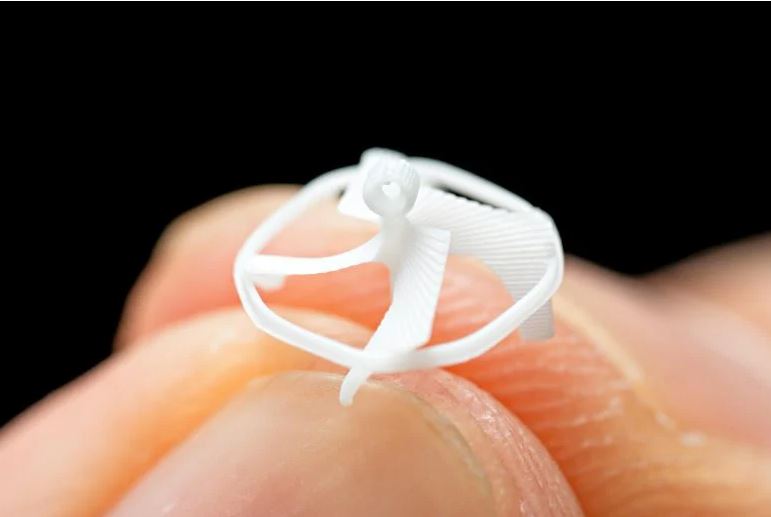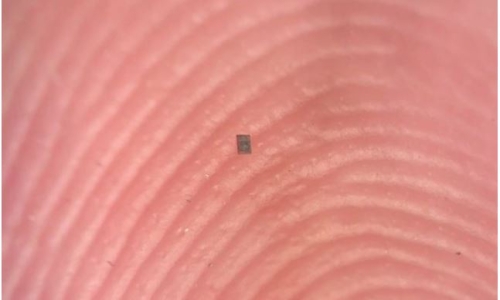


 12:42:28
12:42:28  2025-04-19
2025-04-19  1121
1121

The bumblebee-inspired robot is less than a centimeter wide and can hover, change direction, and hit small targets.
Like a bumblebee moving from flower to flower, a new insect-inspired flying robot developed by engineers at the University of California, Berkeley, can hover, change direction, and hit small targets. Measuring less than 1 centimeter across and weighing just 21 milligrams, it is the smallest wireless robot in the world capable of controlled flight.
“Bees exhibit remarkable aeronautical abilities, such as navigation, hovering, and pollination, that artificial flying robots of similar scale fail to do,” said Liwei Lin, Distinguished Professor of Mechanical Engineering at UC Berkeley. “This flying robot can be wirelessly controlled to approach and hit a designated target, mimicking the mechanism of pollination as a bee collects nectar and flies away.”
Lin is the senior author of a new paper on the robot, published online Friday, March 28, in the journal Science Advances.
Magnetic propulsion powers tiny flight
For a robot to achieve flight, it typically needs a power source, such as a battery, and electronics to control its movement. However, fitting these components into a tiny, lightweight device is a major challenge. To solve this problem, Lin and the UC Berkeley team used an external magnetic field to both power the robot and guide its flight path.
The robot is shaped like a small propeller and includes two small magnets. Under the influence of an external magnetic field, these magnets are attracted and repelled, causing the propeller to spin and generating enough lift to raise the robot off the ground. The flight path of the robot can be precisely controlled by modulating the strength of the magnetic field.
The next largest robot with similar flight capabilities is 2.8 cm in diameter, nearly three times as large as the new flying robot.
Small scale, big possibilities
“Tiny flying robots are useful for exploring small cavities and other complicated environments,” said study co-first author Fanping Sui, who recently completed a Ph.D. in engineering at UC Berkeley. “This could be used for artificial pollination or inspecting small spaces, like the inside of a pipe.”
Currently, the robot is only capable of passive flight. This means that, unlike airplanes or more advanced drones, it has no on-board sensors to detect its current position or trajectory and cannot adjust its movements in real time. So while the robot is capable of precise flight paths, a sudden change in the environment — such as a strong wind — could knock it off course.
“In the future, we will try to add active control, which would allow us to change the robot’s attitude and position in real time,” said Wei Yue, co-first author of the study and a graduate student in the Liwei Lin lab
Toward smarter and swarming robots
Operating the robot also requires a strong magnetic field provided by an electromagnetic field coil. However, further miniaturizing the robot to less than 1 mm in diameter — about the size of a gnat — could make it light enough to be controlled by much weaker magnetic fields, such as those provided by radio waves.
In addition to the new bumblebee-inspired robot, Lin’s team has also created a cockroach-inspired robot that can scurry across the floor and survive being stepped on by a human. And Yue is working on new “swarming” robots that can work together like ants to achieve tasks that would be impossible for individual robots to achieve alone.
“I’m working with 5-millimeter-scale robots that can crawl, roll, and spin, and they can also work together to form chains and arrays, or do even harder tasks,” Yue said. “They could potentially be used in minimally invasive surgery because we could inject a number of them into the body and have them cooperate together to form stents, ablate clots or do other tasks.”
Reality Of Islam |
|

A tiny robo

By applying

Stanford, C

A new study
 9:3:43
9:3:43
 2018-11-05
2018-11-05
10 benefits of Marriage in Islam
 7:5:22
7:5:22
 2019-04-08
2019-04-08
benefits of reciting surat yunus, hud &
 9:45:7
9:45:7
 2018-12-24
2018-12-24
advantages & disadvantages of divorce
 11:35:12
11:35:12
 2018-06-10
2018-06-10
 6:0:51
6:0:51
 2018-10-16
2018-10-16
 6:14:17
6:14:17
 2018-06-21
2018-06-21
 2:2:13
2:2:13
 2022-10-08
2022-10-08
bahlool & the throne of haroun rashid
 8:20:35
8:20:35
 2018-06-21
2018-06-21
 6:0:8
6:0:8
 2023-03-19
2023-03-19
 9:42:16
9:42:16
 2022-10-19
2022-10-19
 1:38:41
1:38:41
 2021-12-08
2021-12-08
 3:43:50
3:43:50
 2022-11-05
2022-11-05
 5:41:46
5:41:46
 2023-03-18
2023-03-18
| LATEST |